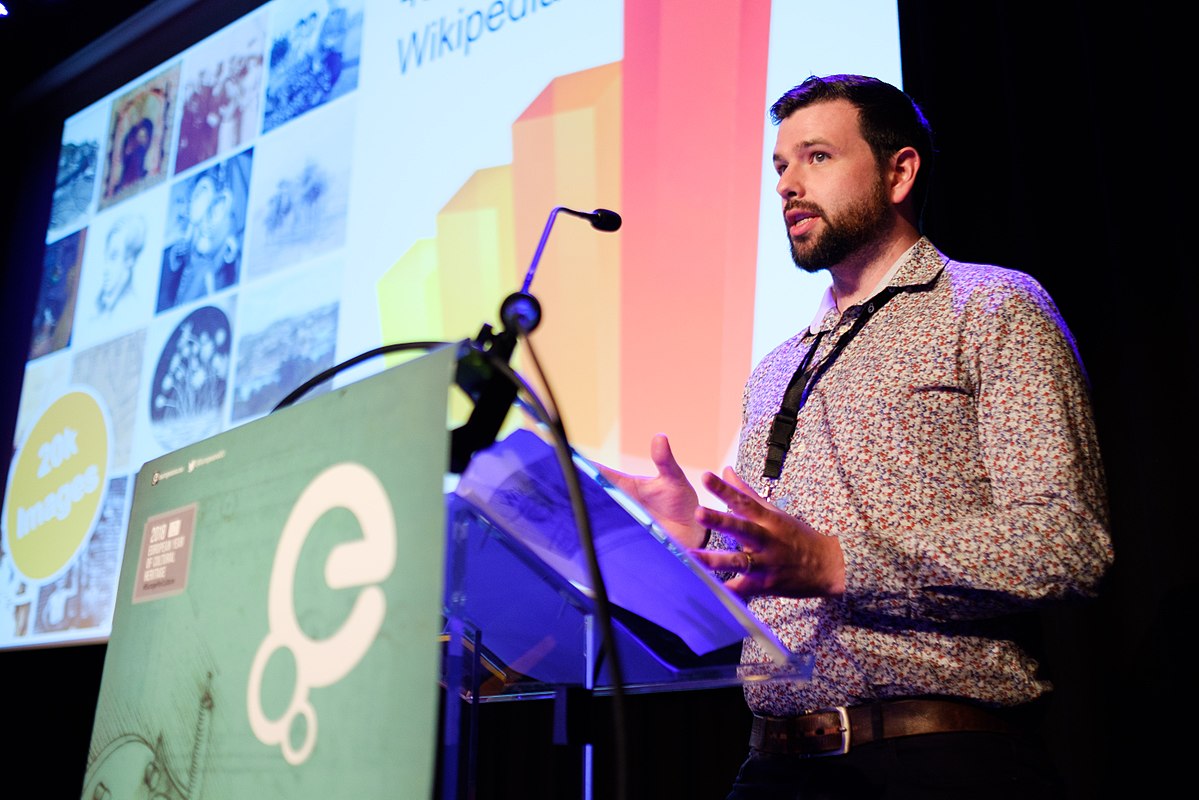By Jason Evans, National Wikimedian at the National Library of Wales
Over 7 years ago the National Library of Wales made the decision not to claim any rights to digital reproductions of public domain works. I was then employed as a Wikimedian, in partnership with Wikimedia UK, to actively begin sharing this content openly on Wikimedia Commons.
To date we have shared over 17,000 images to Commons. Over 70% of these images are now in use on a Wikimedia project, including Wikipedia where views of pages containing our images have reached nearly 730 million. This demonstrates the massive reach which can be achieved through sharing with Wikipedia.
About a year in to the residency, following an introduction to Wikidata from Histropedia’s Navino Evans, we began exploring the possibility of sharing our rich metadata for our open content to Wikidata. We took the time, with the help of volunteers, to create items for relevant artists and photographers, to map descriptive tags to Wikidata depicts statements and to insure that data had Welsh language labels wherever possible.
The best way of exploring and visualising this data was Crotos. The Crotos project is a search and display engine for visual artworks. This website is powered by WikiCommons for images and Wikidata for metadata. At its launch in 2014 the site contained just 8000 images, but by the end of 2019 there are nearly 200,000 paintings, sculptures, drawings, prints, photographs and more.

For years Crotos has been the go to platform for searching, discovering and simply enjoying the one of the worlds largest collections of free art. For Wikimedian’s it is also incredibly useful for demonstrating how structured data can be used to enrich search and discovery of artwork and other visual material, using various Wikidata properties such as depicts, artist, publisher and collection in order to filter content. Images can be displayed on a map based on places depicted and content can be filtered by date of creation. It’s a simple, yet highly effective tool for exploring digital content.
And this got me thinking. Many GLAMs dont have the resources to produce nice portals for exploring their digital content. The National LIbrary of Wales is in a stronger position than many, but even so we have to focus on our core functions – providing access to all our content, including books and archives through a central catalogue system. Our online catalogue is very good for searching for books or specific items from the collection, but it is less useful for those who wish to browse or explore our substantial archive of digital content in a visual and engaging way.
So I reached out to Benoît, the founder of Crotos, and he kindly added Welsh as a language to the Crotos interface. This was great, as it allowed us to benefit from the Welsh language labels, already in Wikidata to give access to our collections and others through the medium of Welsh. Following this, Benoît and I had several discussions at various events about the value of Crotos and the potential for it to form the bases of bespoke interfaces for individual institutions. This would certainly be of benefit to the National Library, but more generally for many smaller GLAMs, such a clear and tangible benefit could help tip the scales towards an open strategic approach.

We are incredibly grateful to Benoît for taking this idea forward. He started modifying a version of Crotos especially for National Library of Wales content! Over a few weeks we tweaked the new site to suit our needs and our collection. The website, named Dwynwen (the Welsh Saint of lovers), retains all the functionality of the Crotos site and adds a few additions, such as links from each image to our own IIIF image viewer, and the addition of a ‘Published in’ facet. ‘Cosmos’ and ‘Calisto’ have been renamed ‘Browse’ and ‘Map’ to fit better with our own standards. Our version simply limits results to items that are part of the National Library of Wales collection.

Speaking about the project, Benoît said;
Since its origins, the web has provided fantastic opportunities to freely explore digital reproductions of artworks, to get information about them, to link them, to browse collections, for knowledge or simply for the pleasure of art experience. Little by little cultural institutions shared their collections online. At the same time, volunteers through the world build or participate in websites about artworks. Wikimedia projects, led by Wikipedia and the goal to share and to give access to all the knowledge, are major players in this movement with many contributors and wide diffusion. Wikimedia Commons, the free-use media repository, and Wikidata, the Wikimedia knowledge database, are great places to gather and structure digital heritage assets and a place where institutions and volunteers can work together. With all that has already been gathered and the technologies that come with them, it is possible to create interfaces, including in the field of art.
Jason Evans, had the idea to create a subset dedicated to the collections of the National Library of Wales, and so Dwynwen was born. And what a great idea! The quantity and quality of the metadata makes it possible to encourage new explorations in those collections. So, for example, we can see more than a hundred views of Snowdon, discover Wales at the end of the 19th century through John Thomas’ photographs, explore prints and illustrations by publications or see extracts of Peniarth Manuscripts.
Thanks a lot to the team investment of the National Welsh Library and Wikidata volunteers that make the Dwynwen possible. Enjoy!
For the National Library, this will give our users a new, and better way of exploring our digital content. Whether you are looking for something specific, like images of Donkeys, bearded men, just the images of women or you just want to explore our photographs, prints or artworks, then ‘Dwynwen’ makes this easy, fun and intuitive.

But this will also be a fantastic tool to demonstrate the value of our open access activity to management, partners and funders, and we hope to use this and other Wiki powered software such as the Dictionary of Welsh Biography timeline, currently in development to change the way we think about giving access to our digital content, and to step up efforts to harness the power of linked open data for content delivery.
‘Dwynwen’ is the result of the National Library of Wales’ enthusiasm and belief in open access principals, together with the hard work of numerous volunteers. We are incredibly grateful to Benoît, for having the vision to develop Crotos, and for his generosity in adapting the platform for us. We are also greatly indebted to Simon Cobb, our Wikidata Visiting Scholar who has done so much work to help share our data to Wikidata, and all the volunteers on Commons and Wikidata who have helped us to share and described our digital content.







